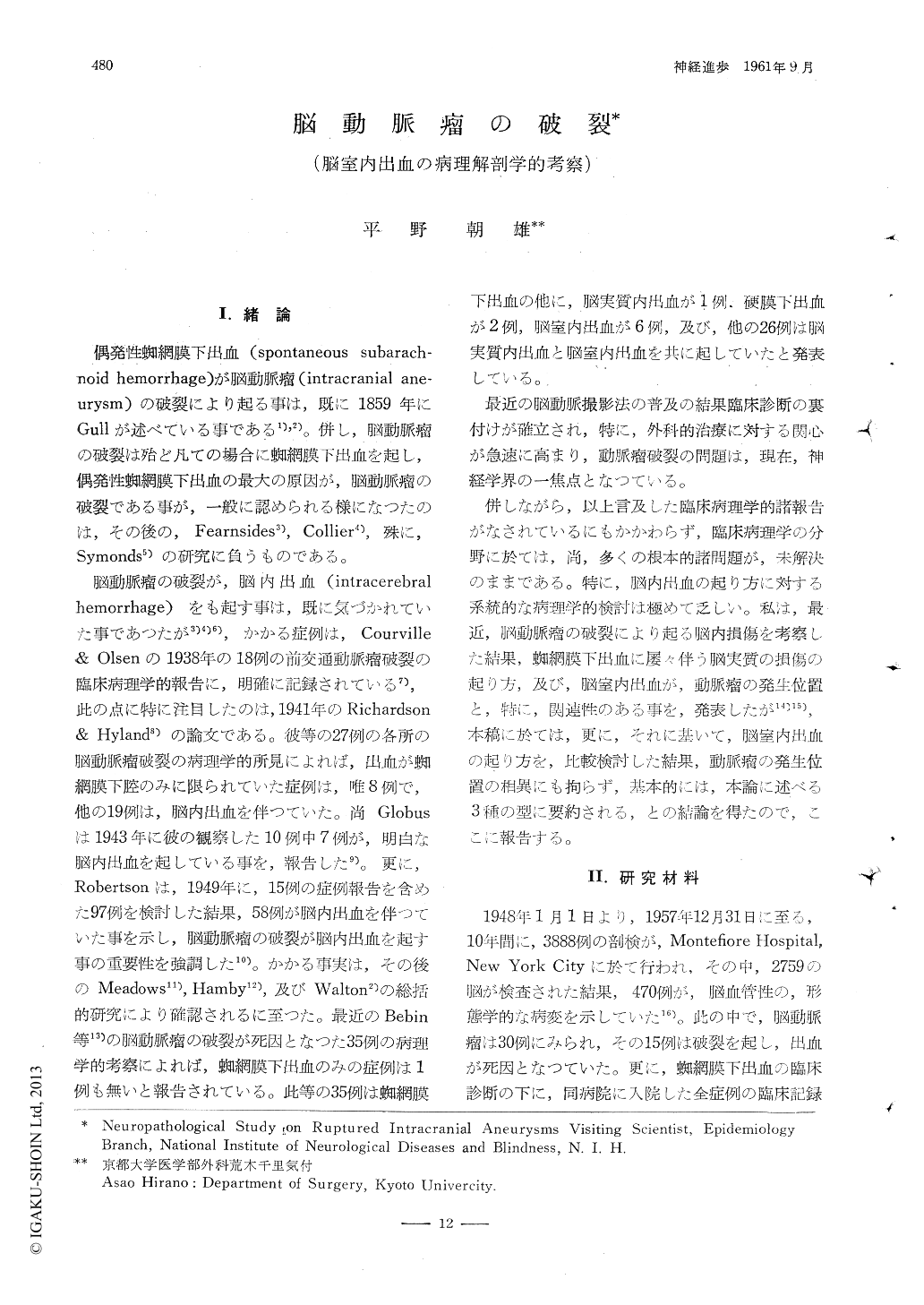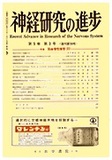Japanese
English
- 有料閲覧
- Abstract 文献概要
- 1ページ目 Look Inside
I.緒論
偶発性蜘網膜下出血(spontaneous subarachnoid hemorrhage)が脳動脈瘤(intracranial aneurysm)の破裂により起る事は,既に1859年にGullが述べている事である1),2)。併し,脳動脈瘤の破裂は殆ど凡ての場合に蜘網膜下出血を起し,偶発性蜘網膜下出血の最大の原因が,脳動脈瘤の破裂である事が,一般に認められる様になつたのは,その後の,Fearnsides3),Colliera4),殊に,Symonds5)の研究に負うものである。
脳動脈瘤の破裂が,脳内出血(intracerebralhemorrhage)をも起す事は,既に気づかれていた事であつたが3)4)6),かかる症例は,Courville & Olsenの1938年の18例の前交通動脈瘤破裂の臨床病理学的報告に,明確に記録されている7),此の点に特に注目したのは,1941年のRichardson & Hyland8)の論文である。彼等の27例の各所の脳動脈瘤破裂の病理学的所見によれば,出血が蜘網膜下腔のみに限られていた症例は,唯8例で,他の19例は,脳内出血を伴つていた。尚Globusは1943年に彼の観察した10例中7例が,明白な脳内出血を起している事を,報告した9)。
Neuropathological study was made in twenty-eight cases of ruptured intracranial aneurysms. Analysis of this material, regarding mechanisms of the intraventricular hemorrhage, revealed three distinct pathological groups :
The first group was characterized by massive bleeding into the subarachnoid space without penetration of the brain tissue. Frequently retro-grade extension of subarachnoid blood was found in the fourth ventricle through foramina Lushka and Magendie. Occasionally blood reached the third and lateral ventricles. This group was made up of nine patients ; three with the ruptured aneurysm of the anterior communicating artery, three with the intracranial portion of the main trunk of the internal carotid aneurysm, two with the aneurysm arising from the junction of the posterior communicating and 'internal carotid arteries, and one with the aneurysm of the posterior inferior cerebellar artery.
The second group was made up of nine patients in whom the hemorrhage resultant from aneurysmal rupture led to disruption of the cerebral tissue and bleeding into the ventricular system. In four cases of the anterior communicating aneurysm, blood ruptured through the gyrus subcallosus and forceps minor of the corpus callosum from below into the rostral horn of the lateral ventricle. In two cases of the internal carotid aneurysm and three cases of the posterior communicating-internal carotid aneurysm, the route of rupture into the ventricle was at the temporal horn through the rostral hippocampal cortex of the temporal lobe in the vicinity of uncus. A cast of blood filled the lateralventricle and extended through the third and fourth ventricles to the foramen of Lushka.
The third group was characterized by bleeding into the cerebral fissure or sulcus and formation of a hematoma, more or less localized within the leptomeninges. Intraventricular hemorrhage occurred secondarily as the result of the necrosis of the adjacent cerebral parenchyma. Ten cases comprised this group. Three cases of the ruptured anterior communicating aneurysm revealed bleeding into the epicallosal sulcus and necrosis of the corpus callosum with consequent rupture and hemorrhage into the body of the lateral ventricles. It was marked by a butterflyshaped hematoma dorsal to the corpus callosum which was depressed and perforated. The anterior cerebral and pericallosal arteries were elevated above the hemorrhage with consequent tearing of the perforating branches which supplied the corpus callosum. Seven cases of ruptured aneurysm of the middle cerebral artery produced hematoma within the Sylvian fissure. The brain and contained ventricular system were displaced and compressed, and intraventricular extension of the hemorrhage occurred in these cases by disruption of the island of Reil and pars opercularis. But the hemorrhagic penetration was usually limited to a short distance, and the actual penetration of the blood into the ventricular system was rare.
These differences in pathology were reflected by symptomatic and radiologic distinctions which might be of value to the clinician with regard to diagnosis and therapy.

Copyright © 1961, Igaku-Shoin Ltd. All rights reserved.


